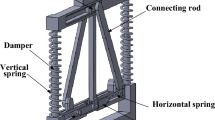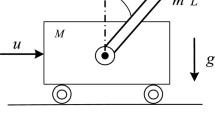Abstract
It is shown that a passive vibration absorber can completely quench the self-excited vibration only for certain parameter values, like the strength of instability in the primary system. The present paper numerically explores the performance of semi-active vibration absorber in controlling self-excited vibration. In the proposed semi-active scheme, the damping force of the absorber is switched between the maximum and the minimum values according to certain control logics. Four different control strategies are considered—these are on–off velocity-based ground-hook control (VBG), on–off displacement-based ground-hook control (DBG), continuous VBG and continuous DBG. Numerical simulations are performed in the MATLAB Simulink to explore the efficacy of the control strategies. It is shown that the on–off DBG control is superior to all other control strategies.





Similar content being viewed by others
References
A. Blanchard, L.A. Bergman, A.F. Vakakis, Passive suppression mechanisms in laminar vortex-induced vibration of a sprung cylinder with a strongly nonlinear dissipative oscillator. J. Appl. Mech. (2017). https://doi.org/10.1115/1.4036942
H.L. Dai, A. Abdelkef, L. Wang, Vortex-induced vibration mitigation through nonlinear energy sink. Nonlinear Sci. Numer. Simul. 42, 22–36 (2017)
Z.-Q. Lu, J.-M. Li, H. Ding, L.-Q. Chen, Analysis and suppression of self-excited vibration via internal stiffness nonlinearity. Adv. Mech. Eng. 9(12), 1–7 (2017)
G. Habib, G. Kerschen, Suppression of limit cycle oscillations using the nonlinear tuned vibration absorber. Proc. R. Soc. A (2015). https://doi.org/10.1098/rspa.2014.0976
I. Kirrou, L. Mokn, M. Belhaq, Effect of fast frequency excitation on tower oscillation under turbulent wind flow. MATEC Web Conf. (2012). https://doi.org/10.1051/matecconf/20120110009
A. Fahsi, Effect of fast harmonic excitation on frequency-locking in a van der Pol–Mathieu–Duffing oscillator. Commun. Nonlinear Sci. Numer. Simul. 14, 244–253 (2009)
S. Sah, M. Belhaq, Control of a delayed limit cycle using the tilt angle of fast excitation. J. Vib. Control 10(2), 175–182 (2011)
J. Warminski, M.P. Cartmell, A. Mituraand, M. Bochenski, Active vibration control of a nonlinear beam with self- and external excitations. Shock Vib. 20, 1033–1047 (2013)
L. Jun, L. Xiaobin, H. Hongxing, Active nonlinear saturation-based control for the free vibration of the self-excited plant. Nonlinear Sci. Numer. Simul. 15, 1071–1079 (2010)
T. Vromen, N. Van de Wouw, A. Doris, P. Astrid, H. Nijmeijer, Nonlinear output-feedback control of torsional vibrations in drillstring systems. Int. J. Robust Nonlinear Control (2017). https://doi.org/10.1002/rmc.3759
S. Chatterjee, On the efficacy of an active absorber with internal state feedback for controlling self-excited oscillations. J. Sound Vib. 330, 1285–1299 (2011)
S. Dehkordi, An active control method to reduce friction Induced vibration caused by negative damping. J Mekanikal 29, 19–34 (2009)
T.G. Ritto, M.G. Tehrani, Active control of stick-slip torsional vibrations in drill-strings. J. Vib. Control (2018). https://doi.org/10.1177/1077546318774240
S. Chatterjee, A.K. Mandal, On the efficacy of an inertial active device with internal time-delayed feedback for controlling self-excited oscillations. J. Sound Vib. 329, 2435–2449 (2010)
R.H. Suarez, H. Puebla, R.A. Lopez, E.H. Martinez, An integral high-order sliding mode control approach for stick-slip suppression in oil drillstrings. Pet. Sci. Technol. 27, 788–800 (2009)
J.H. Koo, M. Ahmadian, M. Setareh, T.M. Murray, In search of suitable control methods for semi-active tuned vibration absorbers. J. Vib. Control 10(2), 163–174 (2004)
Author information
Authors and Affiliations
Corresponding author
Additional information
Publisher's Note
Springer Nature remains neutral with regard to jurisdictional claims in published maps and institutional affiliations.
Appendix 1
Appendix 1
Averaging is employed to system equations (Eqs. (1) and (2)). To this end, the following similarity transformation is defined:
where \(\varPhi = \left[ {\begin{array}{*{20}c} 1 & 1 \\ {\rho_{1} } & {\rho_{2} } \\ \end{array} } \right]\) with \(\rho_{i} = \frac{{1 + \mu \varOmega_{\text{a}}^{2} + \omega_{i}^{2} }}{{\mu \varOmega_{\text{a}}^{2} }}\) and
Using the transformation defined in Eq. (16), Eqs. (3) and (4) are transformed to
where
and
with
and
Assume the solutions of Eq. (23) as
where Ai and θi are slowly varying functions of time and ω is the frequency of oscillation of the system.
Assume
One finally obtains the slow-flow equations as
and
Equations (26) and (27) can be finally recast as
The steady-state solutions of Eqs. (28)–(31) can be obtained by solving the following equations:
Solving Eqs. (1) and (2), one obtains A1, A2, θ and ω. Now transforming back to the physical coordinates, one obtains the amplitude of oscillation of the primary mass and absorber mass, respectively, as
and
Rights and permissions
About this article
Cite this article
Mondal, J., Chatterjee, S. Efficacy of Semi-active Absorber for Controlling Self-excited Vibration. J. Inst. Eng. India Ser. C 101, 97–103 (2020). https://doi.org/10.1007/s40032-019-00521-1
Received:
Accepted:
Published:
Issue Date:
DOI: https://doi.org/10.1007/s40032-019-00521-1




